Prediction of Children’s Subjective Well-Being from Physical Activity and Sports Participation Using Machine Learning Techniques: Evidence from a Multinational Study
Abstract
Highlights
- Machine learning models, particularly XGBoost and LightGBM, predict children’s subjective well-being with up to 50% explained variance, surpassing traditional regression.
- Sports participation, including exercise frequency, emerges as a key predictor, with linear benefits observed across diverse global samples.
- These results support the development of targeted sports programs to enhance child well-being, leveraging advanced predictive tools.
- The findings advocate for integrating physical literacy into educational policies to address global inactivity trends in youth.
Abstract
1. Introduction
- RQ1: Do ML algorithms predict children’s SWB substantially better than conventional linear models, and what is the upper limit on our ability to predict SWB based on survey data?
- RQ2: Are the variables that ML algorithms identify as important in the prediction of children’s SWB aligned with those commonly emphasized in the literature, particularly sports-related factors?
- RQ3: Can ML help to resolve debates about the specific shape of the relationships between children’s SWB and key variables, such as age and frequency of physical activity?
2. Methodology
2.1. Data Source and Preparation
2.2. Models and Evaluation
2.3. Theoretical Prediction Limit
3. Results
3.1. Model Performance
3.2. Feature Importance and SHAP Analysis
3.3. Theoretical Limit and Functional Forms
4. Discussion
- Data limitations: Some variables had up to 20% missing data, which required imputation and may have introduced bias. The absence of longitudinal tracking prevents the assessment of temporal changes or causal pathways.
- Measurement issues: Given the cross-national nature of the ISCWeB dataset, potential cultural and contextual biases in self-reported measures, particularly emotional states and physical activity frequency, may influence results. Although subgroup analyses were conducted to explore regional differences, full measurement invariance testing across countries and cultures was not performed and is recommended for future research. Self-reported SWB in young children (ages 6–7) is especially susceptible to response bias and social desirability effects, which may lead to overestimation of both SWB and physical activity levels.
- Design constraints: The cross-sectional design restricts interpretation to associations rather than causal inferences.
- Model-specific considerations: The competitive but not superior performance of the neural network may be related to the tabular nature of the data, which generally favors tree-based algorithms over deep learning approaches [21].
- Generalizability: Findings may not extend to older adolescents undergoing pubertal transitions (beyond age 14) or to populations not represented in the ISCWeB sample.
5. Conclusions
Author Contributions
Funding
Institutional Review Board Statement
Informed Consent Statement
Data Availability Statement
Acknowledgments
Conflicts of Interest
Abbreviations
| GB | Gradient Boosting. |
| ISCWeB | International Survey of Children’s Well-Being. |
| MAE | Mean Absolute Error. |
| ML | Machine Learning. |
| NN | Neural Network. |
| OLS | Ordinary Least Squares. |
| PIs | Permutation Importances. |
| R2 | Coefficient of Determination. |
| RF | Random Forest. |
| RMSE | Root Mean Squared Error. |
| RQ | Research Question. |
| SHAP | SHapley Additive exPlanations. |
| SWB | Subjective Well-Being. |
| WHO | World Health Organization. |
References
- Diener, E.; Oishi, S.; Tay, L. Advances in subjective well-being research. Nat. Hum. Behav. 2018, 2, 253–260. [Google Scholar] [CrossRef] [PubMed]
- Eime, R.M.; Young, J.A.; Harvey, J.T.; Charity, M.J.; Payne, W.R. A systematic review of the psychological and social benefits of participation in sport for children and adolescents: Informing development of a conceptual model of health through sport. Int. J. Behav. Nutr. Phys. Act. 2013, 10, 135. [Google Scholar] [CrossRef] [PubMed]
- Bull, F.C.; Al-Ansari, S.S.; Biddle, S.; Borodulin, K.; Buman, M.P.; Cardon, G.; Carty, C.; Chaput, J.-P.; Chastin, S.; Chou, R. World Health Organization 2020 guidelines on physical activity and sedentary behaviour. Br. J. Sports Med. 2020, 54, 1451–1462. [Google Scholar] [CrossRef] [PubMed]
- Whitehead, M. Physical Literacy Across the World; Routledge: London, UK, 2019. [Google Scholar]
- Zhang, N.; Liu, C.; Chen, Z.; An, L.; Ren, D.; Yuan, F.; Yuan, R.; Ji, L.; Bi, Y.; Guo, Z. Prediction of adolescent subjective well-being: A machine learning approach. Gen. Psychiatry 2019, 32, e100096. [Google Scholar] [CrossRef] [PubMed]
- Meng, H.; He, S.; Guo, J.; Wang, H.; Tang, X. Applying machine learning to understand the role of social–emotional skills on subjective well-being and physical health. Appl. Psychol. Health Well-Being 2025, 17, e12624. [Google Scholar] [CrossRef] [PubMed]
- Britton, Ú.; Onibonoje, O.; Belton, S.; Behan, S.; Peers, C.; Issartel, J.; Roantree, M. Moving well-being well: Using machine learning to explore the relationship between physical literacy and well-being in children. Appl. Psychol. Health Well-Being 2023, 15, 1110–1129. [Google Scholar] [CrossRef] [PubMed]
- Oparina, E.; Kaiser, C.; Gentile, N.; Tkatchenko, A.; Clark, A.E.; De Neve, J.-E.; D’ambrosio, C. Machine learning in the prediction of human wellbeing. Sci. Rep. 2025, 15, 1632. [Google Scholar] [CrossRef] [PubMed]
- Fu, Q.; Li, L.; Li, Q.; Wang, J. The effects of physical activity on the mental health of typically developing children and adolescents: A systematic review and meta-analysis. BMC Public Health 2025, 25, 1514. [Google Scholar] [CrossRef] [PubMed]
- Caspersen, C.J.; Powell, K.E.; Christenson, G.M. Physical activity, exercise, and physical fitness: Definitions and distinctions for health-related research. Public Health Rep. 1985, 100, 126. [Google Scholar] [PubMed]
- Andresen, S.; Wilmes, J.; Möller, R. Children’s Worlds National Report. Available online: https://isciweb.org/wp-content/uploads/2020/03/Germany-National-Report-Wave-3.pdf (accessed on 14 August 2025).
- González-Carrasco, M.; Casas, F.; Malo, S.; Oriol, X.; Figuer, C.; Boulahrouz, M.; Blasco, A. Children’s Worlds National Report. Available online: https://isciweb.org/wp-content/uploads/2022/08/Catalonia.pdf (accessed on 14 August 2025).
- Breiman, L. Random Forests. Mach. Learn. 2001, 45, 5–32. [Google Scholar] [CrossRef]
- Chen, T.; Guestrin, C. Xgboost: A scalable tree boosting system. In Proceedings of the 22nd Acm Sigkdd International Conference on Knowledge Discovery and Data Mining, San Francisco, CA, USA, 13–17 August 2016. [Google Scholar]
- Ke, G.; Meng, Q.; Finley, T.; Wang, T.; Chen, W.; Ma, W.; Ye, Q.; Liu, T.-Y. Lightgbm: A highly efficient gradient boosting decision tree. Adv. Neural Inf. Process. Syst. 2017, 30, 3149–3157. [Google Scholar]
- Jin, H.; Chollet, F.; Song, Q.; Hu, X. Autokeras: An automl library for deep learning. J. Mach. Learn. Res. 2023, 24, 1–6. [Google Scholar]
- Lundberg, S.M.; Lee, S.-I. A unified approach to interpreting model predictions. Adv. Neural Inf. Process. Syst. 2017, 30, 4768–4777. [Google Scholar]
- Huebner, E.S. Initial development of the student’s life satisfaction scale. Sch. Psychol. Int. 1991, 12, 231–240. [Google Scholar] [CrossRef]
- Jaekel, J. The role of physical activity and fitness for children’s wellbeing and academic achievement. Pediatr. Res. 2024, 96, 1550–1551. [Google Scholar] [CrossRef] [PubMed]
- Kreher, J.B.; Schwartz, J.B. Overtraining syndrome: A practical guide. Sports Health 2012, 4, 128–138. [Google Scholar] [CrossRef] [PubMed]
- Rees, G. Children’ s Views on Their Lives and Well-Being; Springer: Berlin/Heidelberg, Germany, 2017. [Google Scholar]
- Trost, S.G.; Mciver, K.L.; Pate, R.R. Conducting accelerometer-based activity assessments in field-based research. Med. Sci. Sports Exerc. 2005, 37, S531. [Google Scholar] [CrossRef] [PubMed]
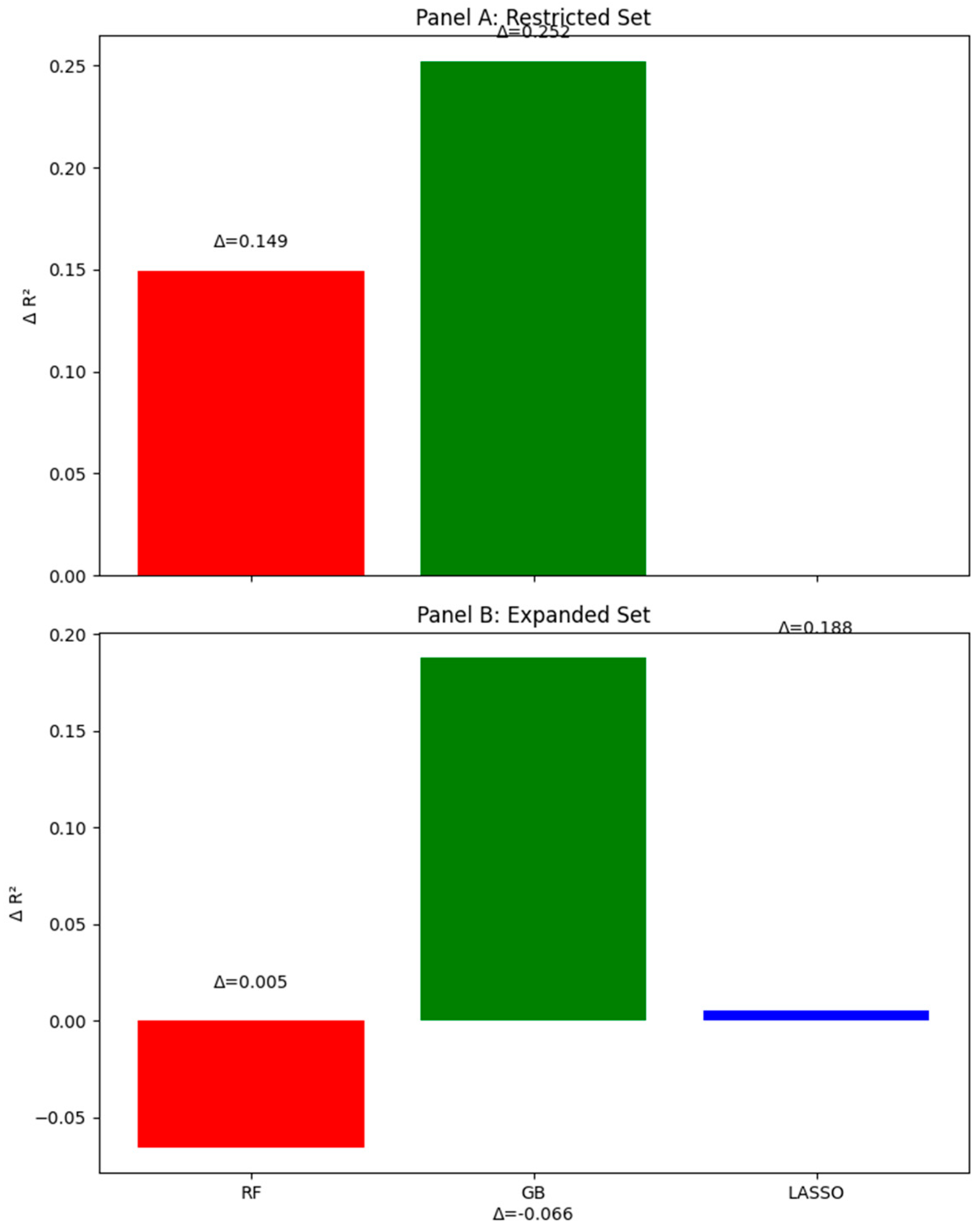
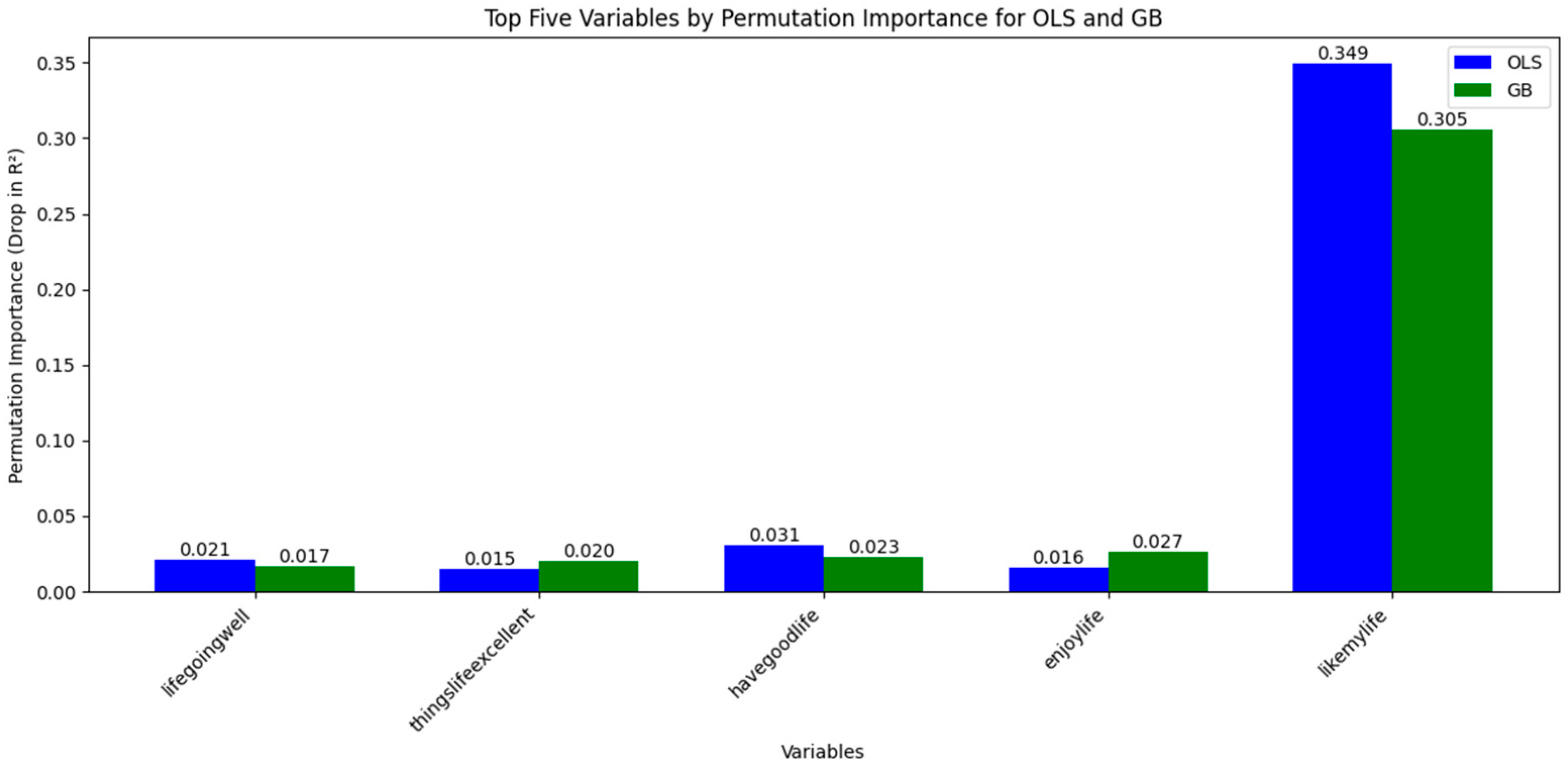
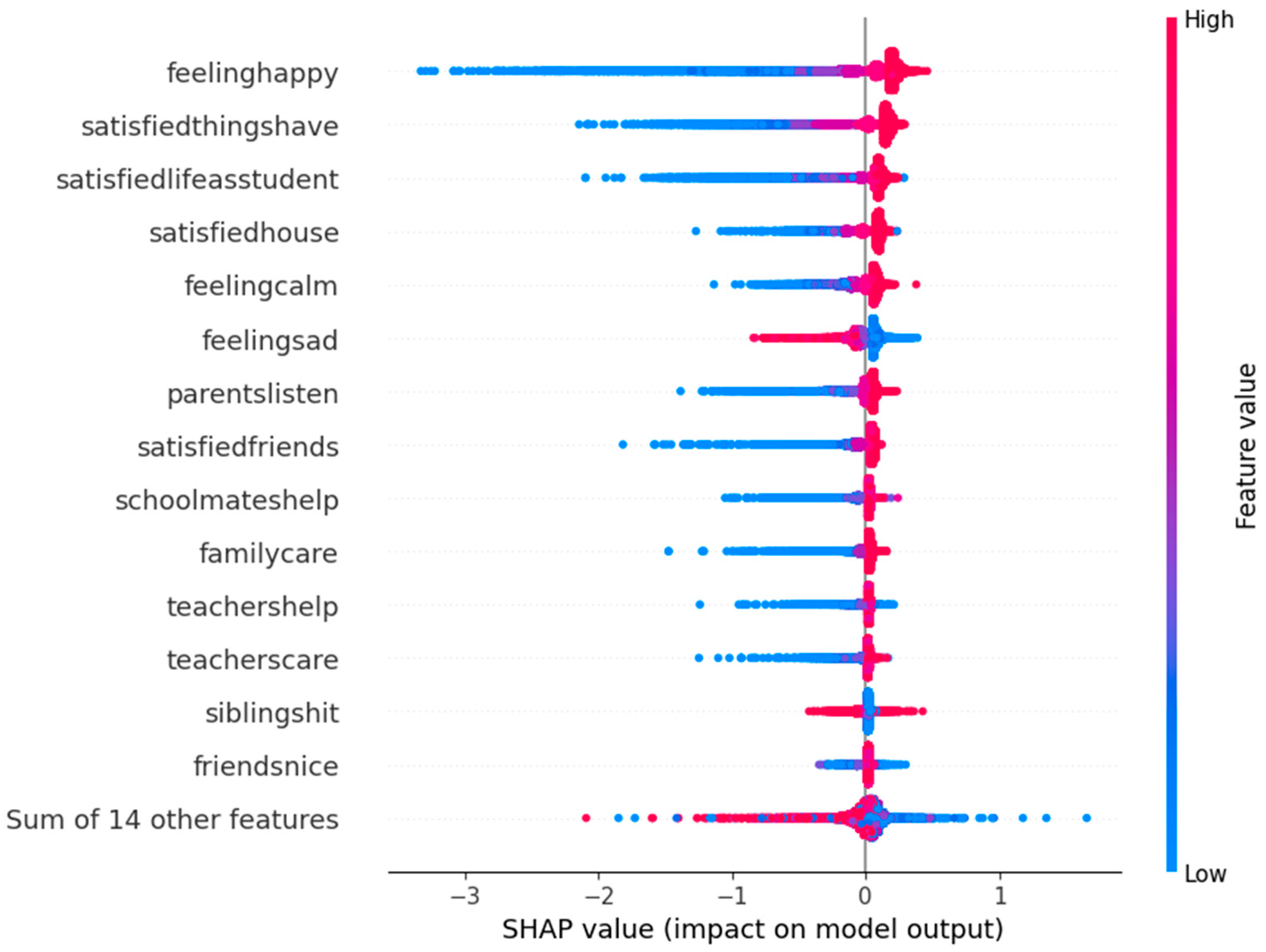
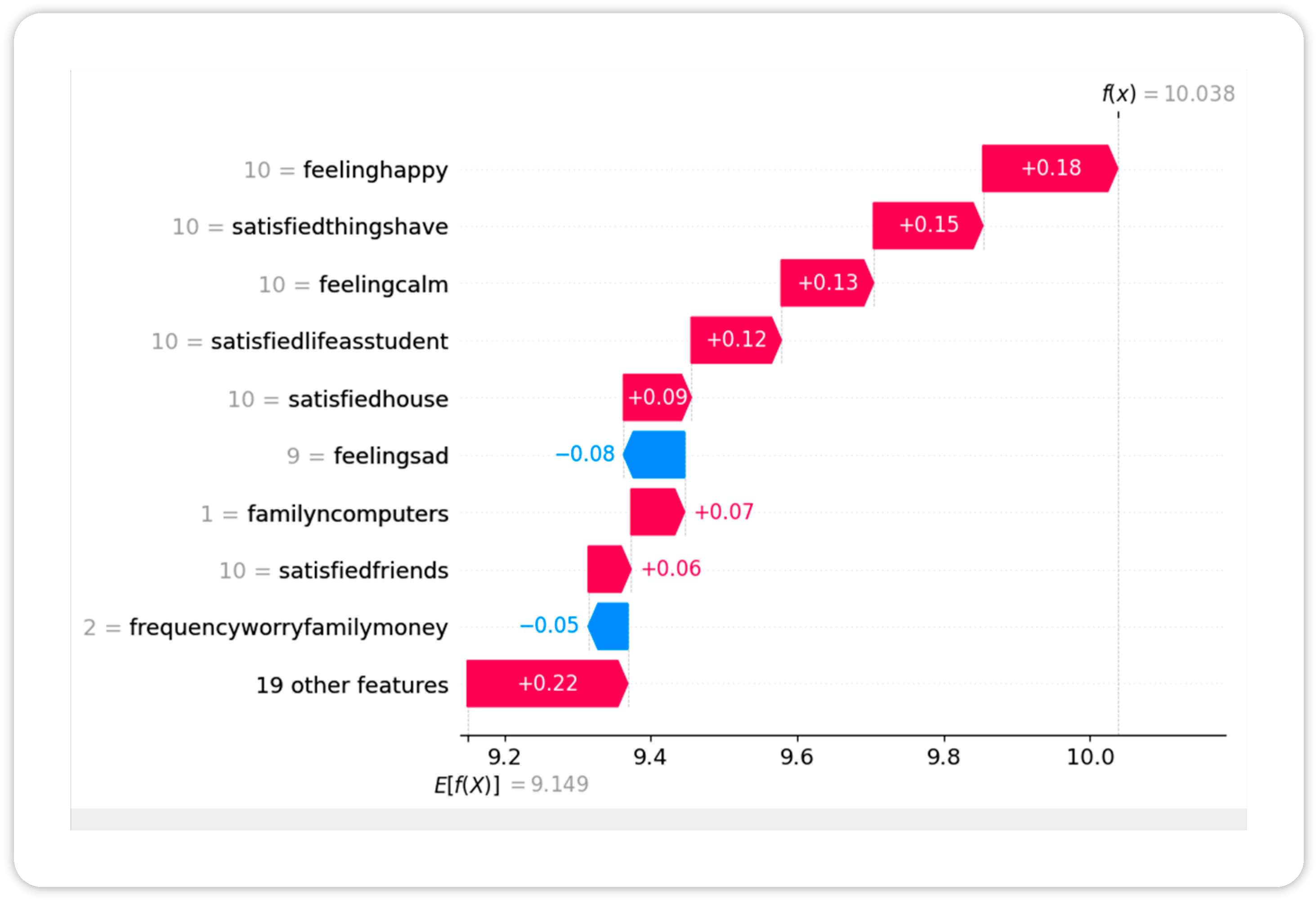
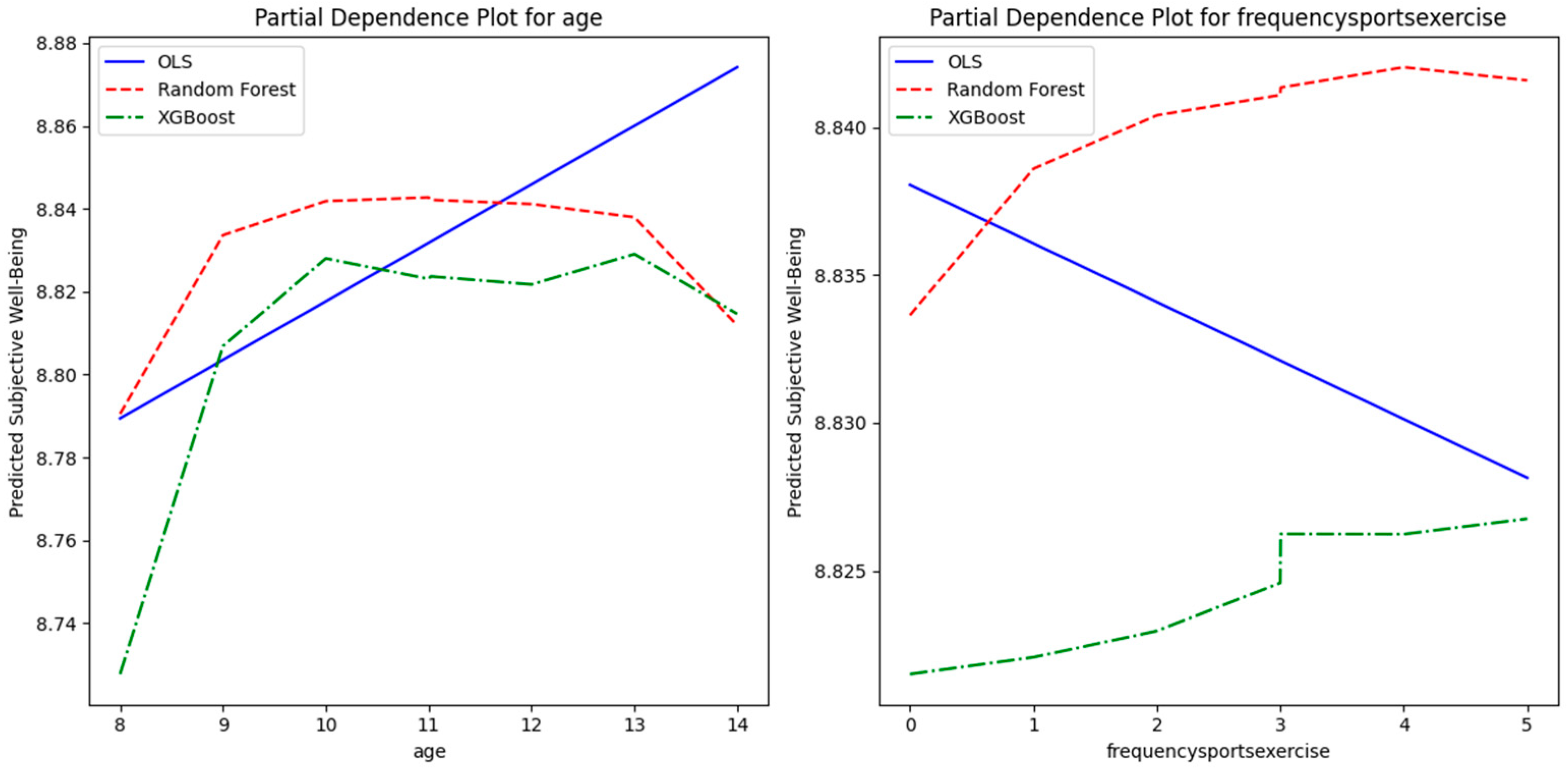
| Dataset | Model | R2 (95% CI) | ΔR2 | MAE | RMSE |
|---|---|---|---|---|---|
| Restricted | OLS | 0.252 (0.23–0.27) | - | 0.742 | 1.323 |
| Restricted | XGBoost (no leakage) | 0.35 (0.33–0.37) | +0.098 | 0.758 | 1.52 |
| Expanded | XGBoost | 0.478 (0.46–0.50) | +0.188 | 0.745 | 1.328 |
Disclaimer/Publisher’s Note: The statements, opinions and data contained in all publications are solely those of the individual author(s) and contributor(s) and not of MDPI and/or the editor(s). MDPI and/or the editor(s) disclaim responsibility for any injury to people or property resulting from any ideas, methods, instructions or products referred to in the content. |
© 2025 by the authors. Licensee MDPI, Basel, Switzerland. This article is an open access article distributed under the terms and conditions of the Creative Commons Attribution (CC BY) license (https://creativecommons.org/licenses/by/4.0/).
Share and Cite
de Souza-Lima, J.; Ferrari, G.; Yáñez-Sepúlveda, R.; Giakoni-Ramírez, F.; Muñoz-Strale, C.; Alarcon-Aguilar, J.; Parra-Saldias, M.; Duclos-Bastias, D.; Godoy-Cumillaf, A.; Merellano-Navarro, E.; et al. Prediction of Children’s Subjective Well-Being from Physical Activity and Sports Participation Using Machine Learning Techniques: Evidence from a Multinational Study. Children 2025, 12, 1083. https://doi.org/10.3390/children12081083
de Souza-Lima J, Ferrari G, Yáñez-Sepúlveda R, Giakoni-Ramírez F, Muñoz-Strale C, Alarcon-Aguilar J, Parra-Saldias M, Duclos-Bastias D, Godoy-Cumillaf A, Merellano-Navarro E, et al. Prediction of Children’s Subjective Well-Being from Physical Activity and Sports Participation Using Machine Learning Techniques: Evidence from a Multinational Study. Children. 2025; 12(8):1083. https://doi.org/10.3390/children12081083
Chicago/Turabian Stylede Souza-Lima, Josivaldo, Gerson Ferrari, Rodrigo Yáñez-Sepúlveda, Frano Giakoni-Ramírez, Catalina Muñoz-Strale, Javiera Alarcon-Aguilar, Maribel Parra-Saldias, Daniel Duclos-Bastias, Andrés Godoy-Cumillaf, Eugenio Merellano-Navarro, and et al. 2025. "Prediction of Children’s Subjective Well-Being from Physical Activity and Sports Participation Using Machine Learning Techniques: Evidence from a Multinational Study" Children 12, no. 8: 1083. https://doi.org/10.3390/children12081083
APA Stylede Souza-Lima, J., Ferrari, G., Yáñez-Sepúlveda, R., Giakoni-Ramírez, F., Muñoz-Strale, C., Alarcon-Aguilar, J., Parra-Saldias, M., Duclos-Bastias, D., Godoy-Cumillaf, A., Merellano-Navarro, E., Bruneau-Chávez, J., & Valdivia-Moral, P. (2025). Prediction of Children’s Subjective Well-Being from Physical Activity and Sports Participation Using Machine Learning Techniques: Evidence from a Multinational Study. Children, 12(8), 1083. https://doi.org/10.3390/children12081083










